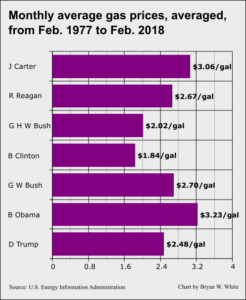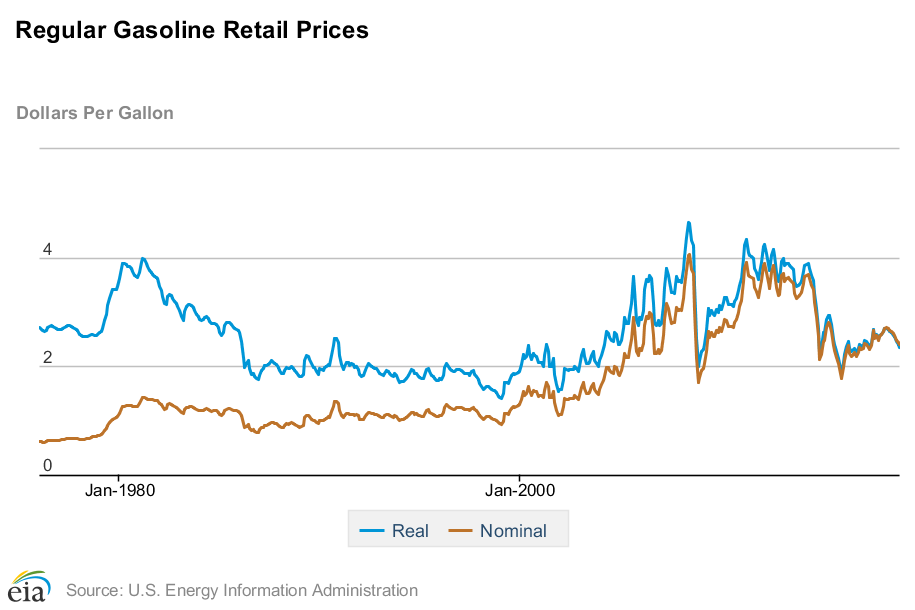Does some form of Trump Derangement Syndrome make it impossible for mainstream media fact checkers to do their work properly?
Consider President Donald Trump’s Interior Secretary Ryan Zinke. And consider PolitiFact.
At the 2018 Conservative Political Action Conference, Zinke claimed that under the Obama administration consumers paid about $100 to fill the tank with gas. Today, Zinke said, it costs about $60.
PolitiFact, using some of the poorest fact-checking practices available, gave Zinke’s claim a “False” rating.
Zinke said, “Under the previous administration it was … $100 to fill a car. American energy has delivered. Now it’s $60. That’s $40 you have in your pocket … that you wouldn’t have.”
The only 40 percent drop in the recent data occurred on Obama’s watch, meaning that Trump’s policies couldn’t have influenced it. On Trump’s watch, the price of gasoline has actually risen by 10 percent.
We rate the statement False.
If Zinke had used much different wording, PolitiFact’s fact check might have made sense. For example, if Zinke had said “Trump policy has delivered” instead of “American energy has delivered” then PolitiFact could easily justify dinging Zinke for claiming Trump policies were responsible for the lower prices.
What did Zinke say?
PolitiFact’s fact check insists that Zinke was citing gas prices under President Obama to imply President Trump brought gas prices down.
Does Zinke’s statement support that interpretation? We have trouble seeing it. We trimmed a C-SPAN video down, providing ample context (bold emphasis given to parts PolitiFact quoted):
Well, on energy: Why is energy important to us?
One: environmentally, no one does it better than the U.S. We have a regulatory framework that ensures accountability. No one does it better than the United States. Now, if you want to see how not to produce energy, I invite you to go to the Middle East or Africa. That’s where the problems are. They’re not in the United States.
Secondly, economically. You know, we talk about the tax bill, and, does everyone like the tax bill that Donald Trump (garbled)? Well, as, as good as the tax bill is, when American pulls up to a pump and they fill their car up every time they fill up, under the previous administration it was $2, $4, $6, $100 to fill a car. American energy has delivered. Now its $60. And that’s $40 you have in your pocket—every American that would fill up to a pump station—that you wouldn’t have. So America (‘s) economy is made on made in American energy, and it should be.
Thirdly, is, you know I spent 23 years in the field and, morally, I never want your kids to ever see what I’ve seen. Ever. And a lot of it is, you know fracking has made such a big difference and getting the regulation out of the way, but I don’t want to ever to be held hostage by a foreign country. Which is important, but also I don’t want our kids to have to fight on foreign shores for energy we have here.
So, I think three ways–so again, environmentally it is better to produce energy here under reasonable regulation than watch it get produced overseas with none. Secondly it’s an economy driver having the ability to produce energy here in this country. And the numbers will show you, we produce, today, about 10.3 million barrels a day in this country, and for the first time in 60 years we’re a net exporter of liquid natural gas and that’s President Donald Trump.
Zinke credited the net exportation of liquid natural gas to Trump by implication. But gasoline prices?
PolitiFact’s framing
Note how PolitiFact framed the issue for its fact check:
Interior Secretary Ryan Zinke touted the Trump administration’s efforts on reducing gasoline prices and, in the process, beefing up Americans’ disposable income.
PolitiFact found that Zinke touted the Trump administration’s role in reducing gasoline prices despite the fact that Zinke didn’t mention any such efforts by the Trump administration. PolitiFact writer Louis Jacobson apparently inferred that Zinke was crediting Trump when he mentioned the high gas prices during the Obama administration. We grant that Zinke’s framing hints at blaming the Obama administration for high gas prices, but Zinke only mentioned two factors driving lower gas prices: fracking and “getting the regulation out of the way.” But the supposed implication was far from concrete.
PolitiFact took the liberty of turning a vague implication into the core target of its fact check.
With its straw man built, PolitiFact proceeded to knock it down with poor and partial fact-checking.
Cherry pickers for Obama
Gas prices started out very low during the Obama administration. The financial crisis that hit near the tail end of the Bush administration shrank demand for oil and gasoline, and the Obama administration inherited those low prices. From there, gas prices in a few years achieved near inflation-adjusted highs over the past 40 years according to the U.S.Energy Information Administration. And the high prices did not represent a mere spike on the graph. Americans paid high prices from 2010 to 2015 before fracking helped boost the supply of gasoline and depress prices again.
Rather than dwelling on the sustained high prices under the Obama administration, PolitiFact painted Obama as the low-gas-price president. PolitiFact did it by ignoring the low prices Obama inherited from Bush and emphasizing the way gas prices came down from Obama administration highs:
Have gas prices fallen?
It’s possible to come up with a 40 percent decline — but the decline came under President Barack Obama, not President Donald Trump.
According to the federal Energy Information Administration, the peak gasoline price under Obama was $3.96 a gallon in mid May 2011. The low price under Trump was $2.33 — the week he was inaugurated in 2017.
That’s a 40 percent decline, but the drop came entirely on Obama’s watch.
For the final two and a half years of Obama’s tenure, the average gallon of gas went no higher than $3.50. It hit a low of $1.73 in February 2016, lower than at any point in the Trump presidency.
This kind of cherry-picked cheer-leading has no place in objective fact-checking. PolitiFact’s Jacobson knows presidents have limited control over the price of gasoline. If President Obama deserves credit for lowering gas prices that credit goes to subsidized alternative sources of energy (lowering demand for oil but at a price) and his administration’s relatively benign view of hydraulic fracturing.
Why would a fact checker take that straw man cherry-picking crown from Mr. Trump and place it on Mr. Obama’s head? Presidents have very limited control over gas prices, and fact checkers know it.
Gas prices trending upward under Trump?
PolitiFact and Jacobson go beyond crediting Mr. Obama with lowering gas prices by identifying an upward trend for gas prices under Mr. Trump.
PolitiFact took about 13 months of gas price data and identified a trend:
Under Trump, the price at the pump has trended upward. From $2.33 at Trump’s inauguration, it rose to $2.56 in mid February 2018. That’s an increase of almost 10 percent.
PolitiFact did not trouble itself to look at reasons behind higher gas prices in 2018. But USA Today reported in January that OPEC has kept a tight rein on oil production while Venezuela experienced an unplanned drop in production:
The key factor driving prices higher is falling supplies of oil. The Organization of Petroleum Exporting Countries has kept a tight lid on output following a recent deal to extend oil production cuts.
And declining production in Venezuela, which is being roiled by political and economic turmoil, has contributed to the price spike.
The fact checker that calls statements lacking important details “Half True” identified a rising trend in gas prices without identifying the reasons behind the rise in gas prices. PolitiFact blamed Trump for the rise at least as surely as Zinke credited Trump with a decrease.
Correcting for PolitiFact’s failings
Fact checkers need not make the errors PolitiFact made. Checking Zinke’s claim ought to have proved simple
- Identify Zinke’s claim: Gas prices are about 40 percent lower now than during the Obama administration
- Test the claim using averaging and inflation adjustments
- Judge whether Zinke’s wording accurately describe d the price changes
- Identify and describe ways Zinke’s wording may have misled his audience
- Rate the claim fairly and consistently in accord with the data.
Instead, PolitiFact’s fact checkers turned misleading aspects of Zinke’s claim into the claim itself (confusing step 4 with step 1). They neglected to use either averaging or inflation adjustments. They skipped judging the accuracy of Zinke’s numbers in favor of taking the misleading aspect of Zinke’s claim and spinning it in President Obama’s favor.

Using government data, we averaged the inflation-adjusted monthly gas price for each president from February of their election year through the end of their term in office. In Mr. Trump’s case we used the last reported month, February 2018, since he continues in office. Obama’s figure was the highest, with President Jimmy Carter a close second. President Bill Clinton registered the lowest figure, with Trump coming in third based on 12 months of data (see Figure 1). Figure 2, showing the Energy Information Administration’s graph of real gas prices, occurs at the end of this article.
How did Obama and Trump compare?
Trump’s 12 month figure of $2.48 per gallon was 23 percent lower than Obama’s average over eight years. While Zinke did not attempt any comparison of the entire record of the two presidents, the numbers help show the irresponsibility of emphasizing the low gas prices during the latter two years of the Obama presidency. The low prices under Obama help support Zinke’s point because the prices came down thanks largely to fracking technologies. And the high overall average price of gas during the Obama administration also supports Zinke’s point, as we show next.
Sustained high prices under Obama
From May 2009, shortly after Obama took office, through December 2014 gas prices stayed over $2.50 per gallon every month. For over five years the monthly average inflation-adjusted price of gas was over $2.50 per gallon. The calculated average over the entire span came to $3.58 per gallon. The average under Trump is over 30 percent less. Is a five-year span out of eight years in office cherry picking?
How about two years, representing about one-quarter of eight years as president? Is two years cherry picking?
From February 2011 through October 2013, a 33-month span, the monthly average inflation-adjusted price of gas stayed above $3.50 per gallon. The average price over that span was $3.90 per gallon. The average monthly price under Trump undercuts that number by 36.4 percent, just a few percentage points from 40 percent.
So was Zinke right or wrong?
We do not think that Zinke was arguing that Trump’s policies brought gas prices down from Obama administration highs. We think Zinke was championing exploitation of U.S. energy resources, including carbon-based sources, to meet U.S. energy demands. The comparison to the Obama administration’s run of high gas prices was intended as a historical reference point, not as a contrast in policy. But certainly Zinke was affirming that Trump administration energy policy would encourage development of U.S. energy reserves through fracking and other advances.
Taken in that sense, Zinke’s claim is true and makes a valid point that technological advances by the U.S. energy sector deserve credit for bringing gas prices down and keeping them low.
However, Zinke’s claim was also delivered with plenty of wiggle room. That type of wiggle room lends itself to things that may mislead an audience. For example, his illustration of 40 percent savings on gas expenses may lead people to think gas prices were higher under Obama than they were. Such exaggerations embedded in vague language allow political figures to let people mislead themselves via anchoring bias.
More background information PolitiFact missed
PolitiFact neglected to tell its readers that its low-gas-price president (Obama) proposed a $10 per barrel tax on oil. PolitiFact also neglected to remind its readers that PolitiFact Virginia ruled it “False” in 2015 that Obama’s policies brought down the price of gas. Why pass up the opportunity to publicize its old fact checks?
We would note in the interest of fairness that Trump also proposed a tax that would raise the price of gasoline: 25 cents per gallon.
Did Obama encourage fracking? At least he did little to stop it, and the one easily identifiable move Obama made to limit fracking was reversed by the Trump administration. The relative inaction of the Obama administration allows it to take some credit for the success of fracking.
A Review of PolitiFact’s Errors
- PolitiFact based its fact check on a dubious interpretation of Zinke’s claim
- PolitiFact ignored the literal truth of Zinke’s claim using a narrow reading
- PolitiFact implied Obama deserved credit for lowering gas prices, contrary to its past finding
- PolitiFact failed to apply averaging
- PolitiFact failed to use readily available inflation-adjusted data
- PolitiFact failed to describe for readers any Obama policy that might have reduced gas prices
- PolitiFact failed to describe reasons for the 10 percent (not adjusted for inflation) rise in gas prices since Trump took office
- PolitiFact failed to tell readers gas prices were higher at the end of the Obama administration than at the beginning
- PolitiFact failed to mention proposals from Obama (and Trump) that would increase gas prices
We judge that PolitiFact’s fact check of Zinke would tend to leave its readers more ignorant for reading it. Aside from its failure to mention Trump’s proposed tax on gasoline, virtually every problem with the fact check helped the fact check reflect positively on the Obama administration. The full set of facts belies that framing.
USEIA Chart: Real and Nominal Gasoline Retail Prices

Figure 2
Clarification March 12, 2018: Struck a redundant occurrence of “available” from the third paragraph.



